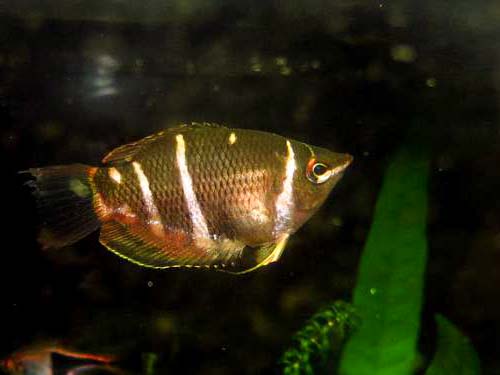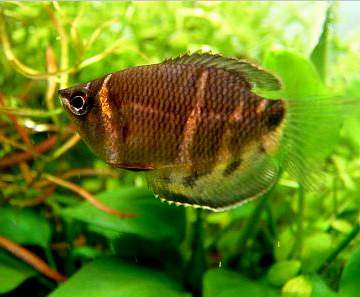Home › Chocolate gourami aquarium › Chocolate gourami – Sphaerichthys osphromenoides.
The Chocolate gourami (Sphaerichthys osphromenoides) belongs to the family Osphronemidae. These chocolate gourami species are native to Malaysia, Thailand and Sumatra and Borneo in Indonesia.
Taxonomy of Chocolate gourami
Scientific Name: Sphaerichthys osphromenoides
Common Name: Chocolate gourami
German: Malaiischer Gurami; Russian: Shokoladnyi gurami; Chinese: 鋸蓋足鱸
Other names: Sphaerichthys, osphromenoides, osphromenoides Canestrini, 1860
Family: Osphronemidae › Perciformes › Actinopterygii › Chordata › Animalia
Species author: Canestrini, 1860
Sphaerichthys osphromenoides is closely related to Sphaerichthys vaillanti (Samurai Gourami), Sphaerichthys selatanensis (crossband chocolate gourami) and S. acrostoma (Giant chocolate gourami).
Description
The chocolate gourami is a small gourami growing up to 2 to 2.4 inches (5-6 cm) in length. It is chocolate brown in color, with 3-4 vertical, whitish, light-yellow or golden bands on the sides. The caudal fin (tail) is almost transparent.
The local populations may have varying degrees of bluish or reddish tinge, particularly on the unpaired fins. These species are air breathing fish and have labyrinth organ.


Habitat
The chocolate gourami mostly inhabits peat swamps (having large amount of decaying plant matter) associated with forests and mangroves. In such environments, the water is poor in mineral content, with a pH range of 4-6 and hardness values of 0.5-6 DH. It prefers warm temperatures around 25–27°C (77–81°F).
Feeding habits
The S.osphromenoides gourami is an omnivore and feeds on decaying plant and algal material as well as small aquatic insects, crustaceans, worms, insect larvae and other zooplankton.
Reproduction
The gourami lay about 20-40 eggs on the substrate and the male fertilizes them. The fertilized eggs are collected by female for mouth-brooding. The female S.osphromenoides have the lower jaw slightly rounded and protruding due to the presence of extensible skin that is expanded during mouth-brooding.
The brooding goes on for about 15-20 days and then fully-formed juveniles are released for their independent life. The males in some populations may have caudal fin more forked when compared to females. The dorsal and anal fins may also appear extended.
Distribution
These S.osphromenoides species are naturally distributed in Peninsular Malaysia, Sumatra and Borneo. Though they were known to exist in Singapore, their present status is not known.
Status and conservation
The status of wild S.osphromenoides population has not been evaluated and so it is unknown. However, the destruction of its natural habitats and reclamation for human use as well as deforestation are the major threats to the survival of these S.osphromenoides species.
The chocolate gourami may get affected by parasites such as sporozoa, protozoa, Tetrahymena and worms. It may also get affected by fungal and bacterial infections.
| Quick chocolate gourami facts and biological classification of Sphaerichthys osphromenoides | |
|---|---|
| Kingdom: | Animalia |
| Phylum: | Chordata |
| Class: | Actinopterygii |
| Order: | Perciformes |
| Suborder: | Anabantoidei |
| Family: | Osphronemidae |
| Subfamily: | Luciocephalinae |
| Genus: | Sphaerichthys |
| Species: | S. osphromenoides |
| Binomial name: | Sphaerichthys osphromenoides |
| Distribution: | S.osphromenoides are naturally distributed in Malaysia, Thailand and Sumatra and Borneo in Indonesia; |
| Feeding habits: | Chocolates gourami are omnivorous and feed on partially decayed vegetation or organic matter, algae, small aquatic insects, small crustaceans, aquatic larvae and worms. |
| IUCN status listing: | Not evaluated |
| Popular posts on Ornamental aquarium fish | |
|---|---|
| Saltwater fish aquarium | Freshwater aquariums |
| Tropical fish diseases | Common aquarium fish diseases |
| Fish bowl aquarium | Fish tank aquariums |
| Finding quality breeding platies | Requirements for breeding platies |
| Breeding of platies by beginners | Male platy – female platy |
| Ornamental fish aquarium hobby | Tropical platy fish care |
| Xiphophorus maculatus | Livebearers |
| Mystery snail bowl | African dwarf frog bowl |
| Dwarf gourami fish bowl | Platy fish giving birth |
| Cobitidae | Corydoras |
| Arowana | Cyprinidae |
| Anabantoids | Cichlidae |
| Characidae | White Cloud Mountain minnow |
| Setting up of ornamental fish bowl | The meaning of ornamental fish |
| Selection of an aquarium tank | Aquarium catfish |
| Betta fish bowl | Goldfish bowl |
| Freshwater aquarium fish types | Freshwater aquarium fish species |
| Fish bowl for ghost shrimp | Fish bowl for guppies |
| Cleaning fish bowl | Requirements for fish bowl |
References on S.osphromenoides:
1.http://www.fishbase.org/summary/Sphaerichthys-osphromenoides.html
1.Image source: https://www.flickr.com/photos/8343980@N06/6616895279/
Image by: kestrel360 / CC BY-NC-ND 2.0 (as on 2016-04-28)
2..Image source: https://en.wikipedia.org/wiki/File:Sphaerichthys_osphromenoides.jpg
2.Image by: Tsunamicarlos / public domain
Current topic in ornamental fish: Chocolate gourami – Sphaerichthys osphromenoides.

